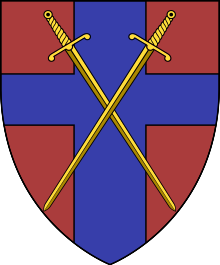27th Anti-Aircraft Brigade was an Air Defence formation of the British Army in the Second World War that served in The Blitz and later converted to infantry.
29th Anti-Aircraft Brigade was an air defence formation of Britain's Territorial Army (TA) before and during the Second World War. It defended East Anglian airfields and ports during the Battle of Britain and The Blitz. It was reformed in the postwar TA.
The 38th Light Anti-Aircraft Brigade was an air defence formation of Britain's Territorial Army formed just before the Second World War, which protected London and Southern England during the Blitz and later converted into an infantry formation for the liberation of Europe.
The 30th (Northumbrian) Anti-Aircraft Brigade was an air defence formation of Britain's Territorial Army from 1936 until 1955, which defended Tyneside and Sunderland during the Second World War.
The 32nd (Midland) Anti-Aircraft Brigade was an air defence formation of Anti-Aircraft Command in Britain's Territorial Army (TA) from 1936 to 1955, charged with defending the East Midlands of England.
The 40th Anti-Aircraft Brigade was an air defence formation of Anti-Aircraft Command in the British Territorial Army (TA) formed shortly before the outbreak of the Second World War. Its initial role was to defend Royal Air Force (RAF) airfields in East Anglia. Later it commanded part of the searchlight belt protecting The Midlands. In 1944 the brigade was moved south to protect the embarkation ports for Operation Overlord and to defend against V-1 flying bombs in Operation Diver. It was briefly reformed in the postwar TA.
The 33rd (Western) Anti-Aircraft Brigade was an air defence formation of Anti-Aircraft Command of the Territorial Army, part of the British Army, formed shortly before the outbreak of the Second World War. It defended Merseyside and West Lancashire during The Blitz.
35th Anti-Aircraft Brigade was an air defence formation of Anti-Aircraft Command in the British Territorial Army (TA) formed shortly before the outbreak of the Second World War. It defended the important naval base of Portsmouth during The Blitz.
The 54th Anti-Aircraft Brigade was an air defence formation of Britain's Territorial Army (TA) formed immediately before the outbreak of the Second World War. It was engaged in defending the West Midlands of England during the war. It comprised a varying number of searchlight (S/L) battalions and later included light anti-aircraft units. It was disbanded at the end of 1943. When the TA was reconstituted in 1947, the former 54th AA Bde was reformed as 80 Anti-Aircraft Brigade but was disbanded on 9 September 1948.
The 41st (London) Anti-Aircraft Brigade was an air defence formation of Anti-Aircraft Command in the British Territorial Army, formed shortly before the outbreak of the Second World War. Its role was to defend East Anglia.
36th (Scottish) Anti-Aircraft Brigade was an air defence formation of Britain's Territorial Army, created in the period of tension before the outbreak of the Second World War. It was responsible for defending eastern Scotland.
The 37th Anti-Aircraft Brigade was an air defence formation of Britain's Territorial Army (TA) formed just before the outbreak of the Second World War. It was engaged in defending the Thames Estuary during the war, and continued to form part of Anti-Aircraft Command in the postwar era.
39th Anti-Aircraft Brigade was an air defence formation of Britain's Territorial Army (TA) during the Second World War. It was responsible under Anti-Aircraft Command for protecting industry along the Humber Estuary and airfields in Lincolnshire during The Blitz. Later it defended the coast of East Anglia against Luftwaffe 'hit-and-run' attacks. It was later converted to a field force formation, covered the embarkation ports for Operation Overlord and defended London against V-1 flying bombs. It served in the campaign in North West Europe, defending Antwerp against V-1s and supervising the clean-up of the notorious Bergen-Belsen concentration camp.
42nd Anti-Aircraft Brigade was an air defence formation of Britain's Territorial Army (TA). It was responsible for protecting the area around Glasgow and industry along the Firth of Clyde during the Second World War.
43rd Anti-Aircraft Brigade was an air defence formation of Britain's Territorial Army (TA). Formed in 1938, it was responsible for protecting Teesside in North East England during the early part of the Second World War, and later defended South East England from V-1 flying bombs. It was reformed postwar and survived under different titles until 1961.
50th Light Anti-Aircraft Brigade was an air defence formation of Britain's Territorial Army (TA) during the Second World War. It defended the North Midlands of England during The Blitz and later helped to protect Brussels from V-1 flying bombs during the Campaign in North West Europe.
6th Anti-Aircraft Brigade was an air defence formation of the British Army formed during the Second World War. It served in the disastrous Norwegian Campaign in 1940 and then defended East Anglia during the Battle of Britain and The Blitz. It was reorganised to take part in the invasion of Normandy, but instead was diverted to defending Southern England against V-1 flying bombs. It was briefly recreated in the postwar Regular Army.
44th Anti-Aircraft Brigade was an air defence formation of Britain's Territorial Army (TA). Formed in 1938, it was responsible for protecting Manchester and later the Isle of Wight during the Second World War. It was reformed postwar under a new title, and continued until 1955.
45th Anti-Aircraft Brigade was an air defence formation of Britain's Territorial Army (TA). Formed in 1938, it was responsible for protecting South Wales during the Second World War. It was reformed in the postwar TA under a new title, and continued until 1955.
52nd Light Anti-Aircraft Brigade was an air defence formation of Britain's Territorial Army (TA) during the Second World War. Formed on the outbreak of war to control static searchlight (S/L) sites in Scotland, it later operated as a headquarters (HQ) for mobile anti-aircraft (AA) gun units in the Allied invasion of North Africa and subsequent Italian Campaign.

